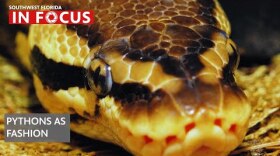-
Invasive species have been wreaking havoc on Florida, and one Miami-based company may have found the perfect solution to dealing with unwanted critters. Turn them into fashionable accessories.
-
Commissioners with the Florida Fish and Wildlife Conservation Commission (FWC) have approved staff recommendations to advertise proposed rule changes for nonnative species, including prohibited green iguanas.No further hearing is required unless requested. Green iguanas are invasive reptiles that are not native to Florida.
-
Southwest Florida’s landscape is graced by numerous native plant species. From towering longleaf pine trees with their prickly pinecones bobbing in the breeze, to the leatherleaf ferns that blanket the marshy bald cypress forest floors, there is so much more to these native ecosystems than meets the eye.
-
Spring brings more than blooming flowers and a rise in temperature; it also means that cane toad breeding season begins.
-
Experts from academic, government and non-profit agencies gathered to evaluate potential invasive species to Florida based on the likelihood of arrival, likelihood of establishment and spread, and potential ecological, economical and human health impacts. Of 460 vertebrates, invertebrates, algae and plants determined to have some invasive characteristics suitable to Florida, 40 species were classified as being at higher risk of invasion. The determination of a species as high-risk does not mean it is of immediate concern; more thorough analyses are required to consider, for example, placement on a monitoring or regulatory list.
-
A coordinated series of efforts over 10 years to eradicate the spectacled caiman from the Western Everglades resulted in the removal of 251 of the creatures
-
Naples resident Jake Waleri, who is 22 and an amateur python hunter, caught a world-record 19-footer with some friends earlier this month in the Big Cypress National Preserve.
-
Fifteen years ago, there was no noticeable problem with the Carolina willows at Audubon’s Corkscrew Swamp Sanctuary. Slowly, the native plant species grew to the extent of being considered invasive.This particular willow, almost by itself, has expanded the definition of “invasive species” to include particularly aggressive plants that are native to Florida, not just faraway exotics.
-
As director of new UF/IFAS Invasion Science Research, Dr. Matthew Thomas will bring together more than 120 UF/IFAS scientists dedicated to the control of nonnative and invasive wildlife and plant species.
-
Let’s say that, for fun, you wanted to go into alligator-infested area, hip-deep in water where you can’t see the bottom, standing in mushy marl, in the middle of the night, and try to capture a huge snake that in turn may want to capture you. Then, the Florida Gov. Ron DeSantis’ “2022 Florida Python Challenge®” is for you.
Play Live Radio
Next Up:
0:00
0:00
Available On Air Stations










